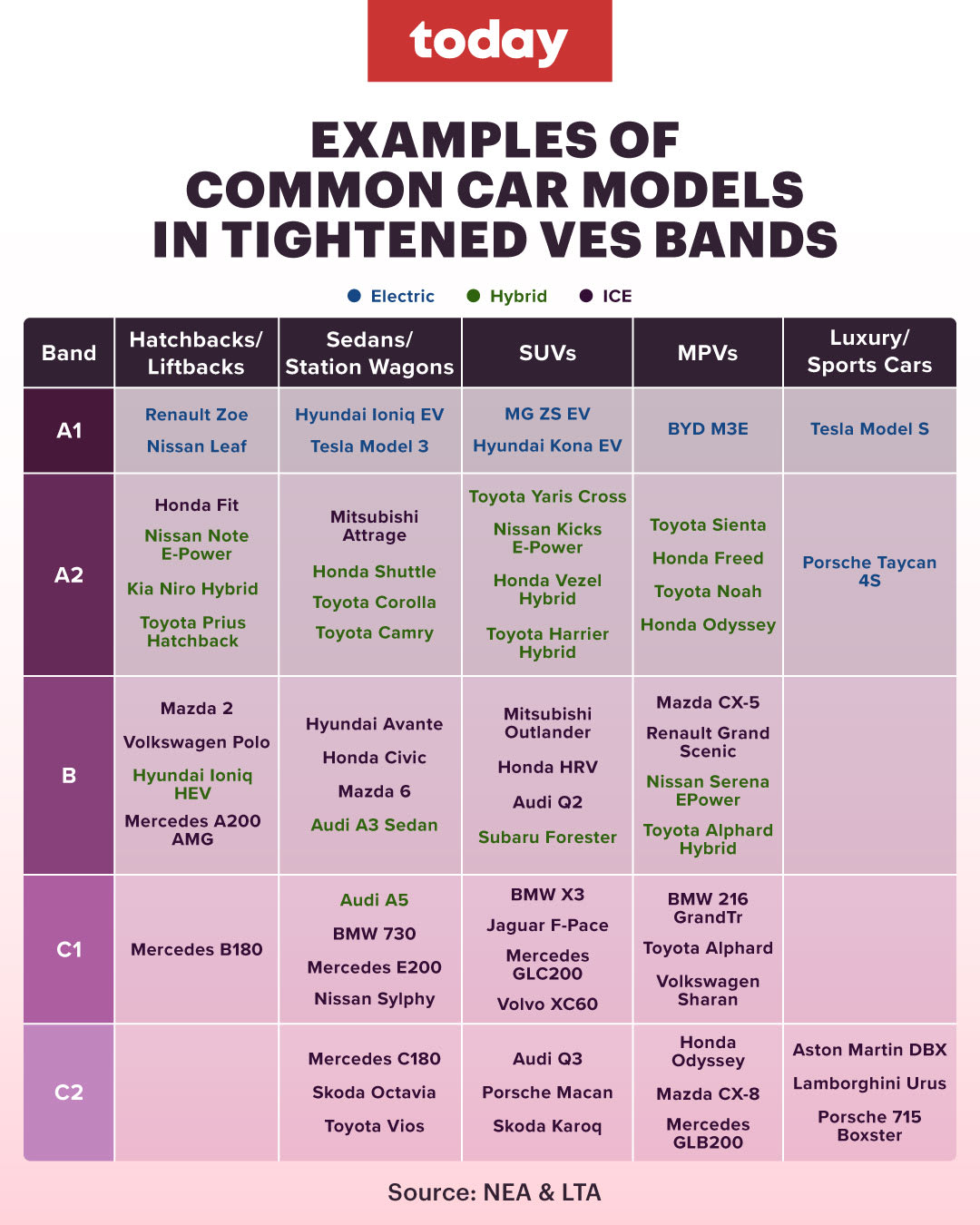Emission thresholds to be tightened in rebate, surcharge scheme to encourage purchase of 'cleaner' cars

- A scheme that offers a carrot and stick approach of rebates and surcharges to encourage cleaner car purchases will have its pollutant thresholds tightened from January 2024 onwards
- The Vehicular Emissions Scheme (VES), was introduced in 2018 to encourage buyers to choose cars with lower emissions across five pollutants
- While the VES is a step in the right direction, it may not be enough to sway prospective car buyers, said transport analysts and car dealerships
SINGAPORE — A scheme that offers tiered rebates and surcharges to car buyers, with the amounts based on how clean or polluting the emissions from the car model are, will have its pollutant thresholds tightened from January 2024 onwards.
However, transport economists and analysts who spoke to TODAY said that although the changes to the Vehicular Emissions Scheme (VES) are a step in the right direction, it is unlikely to drive mass adoption of electric vehicles (EVs) in the near future.
This is due to other factors such as insufficient infrastructural support — charging stations, for example — and an inability to fulfil the needs of buyers.
The VES was introduced in 2018 to encourage buyers to choose cars with lower emissions across five pollutants such as carbon dioxide, hydrocarbons and carbon monoxide.
In a joint press release on Thursday (June 30), the National Environment Agency (NEA) and the Land Transport Authority (LTA) announced that "only cars with zero tailpipe emissions" such as EVs will qualify for the revised A1 band.
Under the A1 band, car buyers are now entitled to a rebate of S$25,000, or S$37,500 for taxis. The amount applying from Jan 1, 2024 is yet to be announced.
Examples of A1 band cars falling under the tightened emission standards applying from 2024 include the Renault Zoe, Nissan Leaf, Hyundai Ioniq EV and Tesla Model 3.
EVs with higher power consumption, most hybrids and some pure internal combustion engine cars that are smaller and more efficient would qualify for the tightened A2 band. Some examples of qualifying cars include the Honda Fit, Mistubishi Attrage, Toyota Yaris Cross and Toyota Sienta.

At the other end of the spectrum, cars in the tightened C2 band include the Mercedes C180, the Toyota Vios and the Honda Odyssey. Those vehicles are subject to a surcharge of S$25,000, or S$37,500 for taxis — a penalty level that will continue to apply until Dec 31, 2025.
The move will "clearly distinguish pure internal combustion engine cars, cleaner alternatives such as hybrids and electric vehicles", the press release stated.
There will not be any changes to the VES rebate until the end of 2023 and VES surcharge till the end of 2025, but applicable VES rebates from January 2024 will be announced in 2023.
'NOT ENOUGH TO CHANGE DRIVING HABITS'
While the VES is a step in the right direction, it may not be enough to sway prospective car buyers, transport analysts and car dealerships said.
Mr Ray Perumal, the manager for VIP Auto Nation, which sells both new and used cars, said that incidents of exploding EVs have also deterred people from making the switch.
“The VES just gives you a price benefit or price penalty, depending on the vehicle, but at the end of the day, as the vehicle purchaser, you are the one who is still deciding whether the vehicle you're interested in meets your needs or not.Transport economist Walter Theseira”
He added that there is a need for more mass market vehicle models that can serve the needs for buyers with families. "Because these vehicles will then most likely both qualify for the top rating of the VES as well as also satisfy people's needs," he said.
Other factors, such as having not enough charging ports could also be an issue for buyers.
Transport analyst Terence Fan from the Singapore Management University said: "I think a big obstacle is going to be infrastructure because unless you can do solid charging on the go, you still have to rely on a plug.
"That's where the decision-making is. Let's say you live in an HDB (Housing and Development Board flat) and in the car park, there are five charging stations, which will be used up at night. If you are the sixth vehicle, would you want to buy an EV and play musical chairs?"
When asked if there is a sum sufficient to push prospective buyers over to EVs, Dr Fan said: "In people's minds, cost is a cost, but there are daily operational issues like, 'Do I get my charging done?' That is also very important and probably outweighs the one time cost."
He added that high Certificate of Entitlement (COE) prices also overshadow the rebates offered by the VES.

Associate Professor Michael Li from Nanyang Technological University, a transport researcher, said that tightening the pollutants threshold is a step in the right direction, but in order to encourage mass adoption of EVs, more initiatives such as a carbon tax on emissions would also help push buyers.
He said that this would be another deterrent for prospective car buyers.
He added that the move should be understood in a larger context of the global push towards EVs and "clean air cars".
Mr Richmond Chan, the sales director of car dealership Midas Automobile, a used car dealership, did observe that there has been a greater preference for EVs in the past two years.
"It's the market trend that I'm seeing," he said. "The new 'in' thing are EVs... but this is because of Tesla. EVs have doubled from 2020 to 2021 and I am seeing so many more Tesla (cars) on the road."











